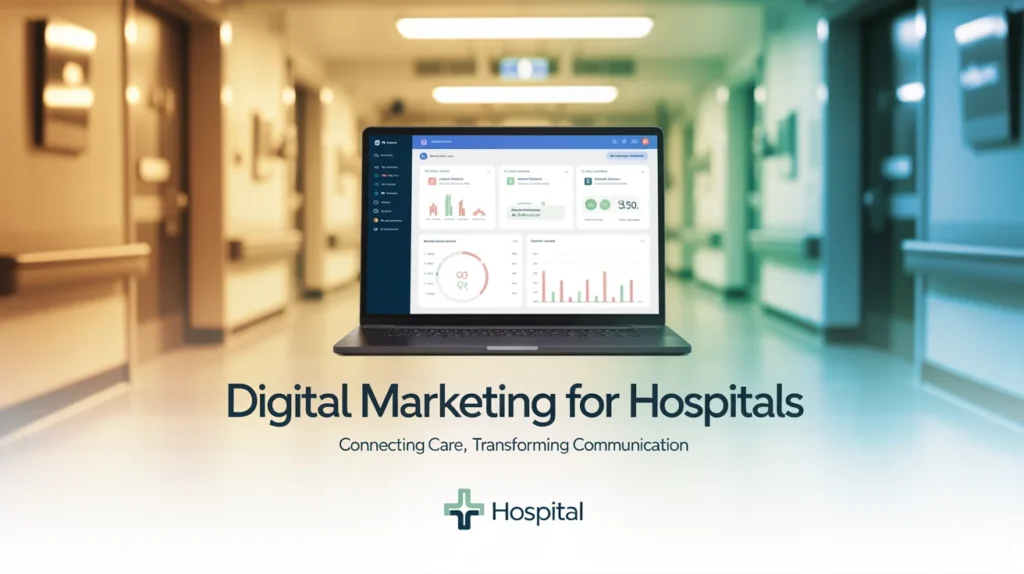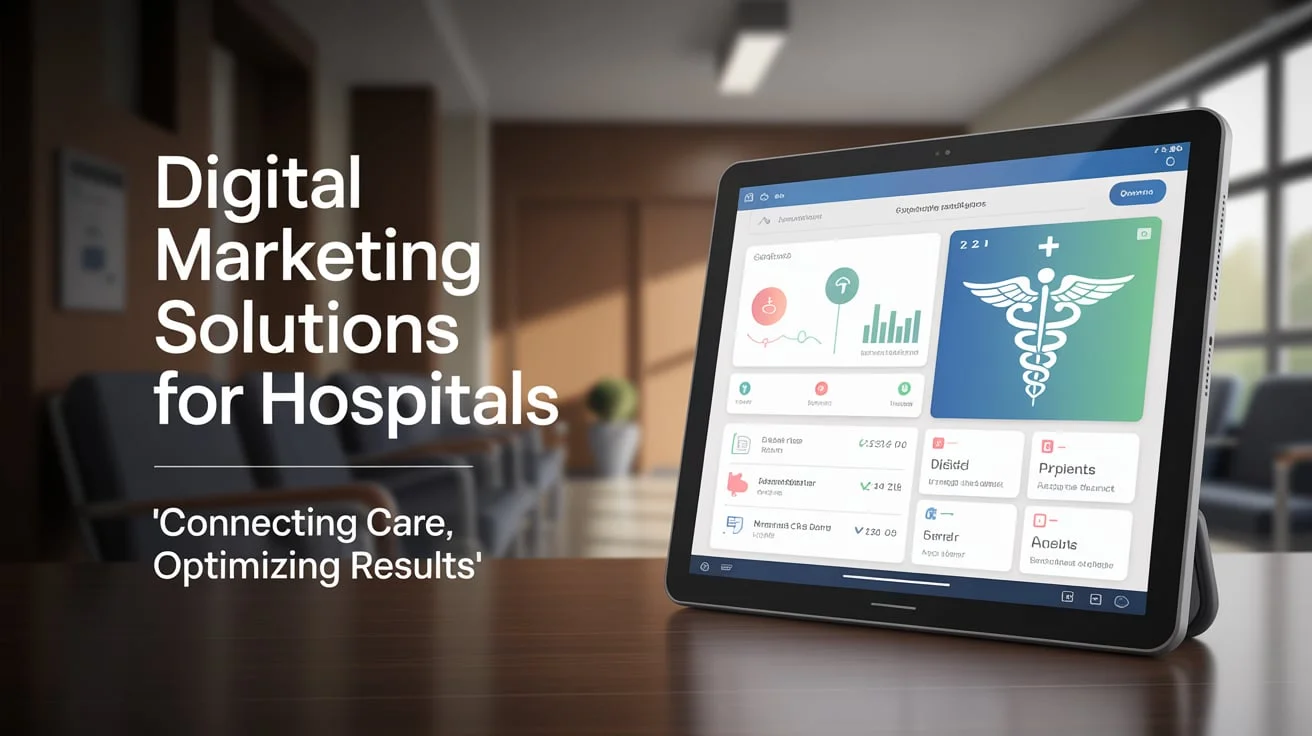In today’s digital age, hospitals need more than doctors and equipment to thrive. They also need visibility, trust, and strong patient engagement. Digital marketing for hospitals is no longer optional; it’s a strategic need.
With the rise of online search for health-related queries, your hospital must be discoverable, reputable, and informative.
Patients now make healthcare decisions by reading reviews, checking websites, and comparing services. Let’s explore how digital marketing can make your hospital stand out.
Why Digital Marketing Is Crucial for Hospitals in 2025
Digital marketing helps hospitals build a strong online presence. It supports branding, drives more patient bookings, and increases local visibility. Traditional marketing alone can’t compete with the targeted precision of digital strategies.
The healthcare industry has seen massive shifts post-COVID. Patients now seek healthcare services online, from finding a specialist to reading about treatments. This behaviour makes digital marketing a powerful bridge between hospitals and patients.
Benefits of a Strong Digital Marketing Strategy
An effective digital marketing plan can change how your hospital interacts with patients. It builds loyalty, boosts search rankings, and increases trust.
Here are some top advantages:
- Higher Patient Trust: With online reviews, blogs, and testimonials, you build credibility and comfort.
- Better Engagement: Social media, email, and website content allow two-way communication.
- Data-Driven Growth: Analytics help track what’s working and improve campaigns.
Key Strategies in Digital Marketing for Hospitals
To be successful, your hospital must implement a full-scale digital approach, including SEO and social media.
Start with the basics, optimise your website for mobile, use proper medical content, and apply local SEO tactics. These small changes can deliver significant results.
Here are essential strategies for hospitals:
- Search Engine Optimization (SEO) helps your hospital appear in Google when people search for symptoms, treatments, or nearby clinics.
- Content Marketing: Articles, guides, and blogs educate patients and improve rankings.
- Google My Business Optimization: Appears in local search results and maps, increasing walk-ins.
Top Channels That Drive Patient Acquisition

Each hospital must choose the right mix of marketing channels based on goals and target audience. Not every platform is effective for every hospital.
Use these top-performing channels for the best results:
- Facebook and Instagram: These are for community engagement and promoting wellness campaigns.
- Email Marketing: For appointment reminders, health tips, and follow-ups.
- Paid Ads (Google Ads, Meta Ads): To drive traffic and boost urgent care bookings.
Local SEO: Bring Nearby Patients to Your Hospital
Local SEO is a game-changer. It helps people near your hospital find you easily when they search for medical help online. Optimizing your hospital’s Google profile, adding local keywords, and earning local backlinks all matter.
Hospitals often overlook this strategy, but it’s one of the most cost-effective methods for increasing patient visits.
Key local SEO tactics include:
- Claim and verify your Google Business Profile
- Use geo-specific keywords like “best hospital in [city name]”
- Ask satisfied patients to leave positive Google reviews.
Content That Builds Authority and Educates Patients
Publishing medical blogs, videos, and case studies can make your hospital a trusted authority. This is essential for Google EEAT (Expertise, Experience, Authoritativeness, and Trustworthiness).
When your content is helpful and written by real medical experts, patients feel more confident about choosing your facility. Use real stories, expert interviews, and infographics.
High-authority content can include:
- Articles about diseases, symptoms, and treatments
- Doctor Q&A sections
- Preventive care guides and seasonal health tips
Reputation Management: Trust Is Everything in Healthcare
People check reviews before choosing a hospital. One bad review can impact your credibility. That’s why online reputation management is crucial.
Hospitals should actively monitor patient feedback, address complaints, and highlight positive testimonials across digital channels.
Responding to feedback shows patients that you care and are constantly improving.
Website Optimization and UX: First Impressions Matter
Your website is your digital front door. It must be easy to navigate, mobile-friendly, and fast-loading. A poor website can cost you patients.
Patients want to see clear information, such as contact numbers, specialties, insurance details, and booking options. Add trust signals like certifications, doctor bios, and success rates.
Best practices for hospital websites:
- Use live chat or a chatbot to guide visitors
- Add online appointment booking.
- Make it accessible for all devices.
Video Marketing: Showcase Your Hospital’s Strength
Video marketing builds a human connection. You can use videos to introduce doctors, explain procedures, and showcase facilities.
Patients connect better when seeing real faces and stories than just reading text. Videos also perform well on social media and YouTube.
Types of effective hospital videos:
- Doctor introductions
- Behind the scenes of the departments
- Patient success stories
- Health tips from specialists
Paid Ads to Boost Visibility in Competitive Areas
Running paid ads helps hospitals appear instantly in front of patients. Paid ads give you a head start, especially when competing with large private clinics.
Use platforms like Google Ads to target local patients looking for services like “pediatrician near me” or “emergency care open now.” Paid campaigns, combined with strong landing pages, bring fast results.
Effective paid ad strategies:
- Use location targeting
- Focus on service-based keywords.
- Monitor ad performance using Google Analytics.
Email Marketing: Personalized Patient Communication
Email marketing keeps you connected with patients after their visit. It’s also a great way to educate them on new services, updates, or health tips.
Sending regular newsletters builds familiarity. It also reminds patients of follow-up appointments or new offerings like diagnostic tests.
Measuring ROI: Use Data to Guide Strategy
Every digital campaign must be measurable. Use analytics tools like Google Analytics, SEMrush, or HubSpot to track what’s driving conversions.
Monitor KPIS like traffic sources, click-through rates, and appointment bookings. Data tells you which strategies to scale or stop.
Challenges Hospitals Face in Digital Marketing
Despite its benefits, hospitals face budget limits, data privacy concerns, and regulatory compliance. Striking a balance between promotion and ethical boundaries is vital.
Overcoming these challenges requires:
- Educating staff about digital tools
- Hiring or partnering with healthcare marketing experts
- Prioritizing compliance with HIPAA and local laws
Conclusion:
Digital marketing for hospitals is not just about visibility; it’s about trust, engagement, and growth. By combining SEO, content, social media, and reputation management, your hospital can stay competitive and connected to the community.
Start with small steps, optimise your website, claim your Google profile, and publish educational content. These actions will help your hospital gain more trust and patients online.
Remember, digital marketing is a continuous journey. The more consistent and patient-centred your approach, the more your hospital will thrive in the digital world.
Frequently Asked Questions:
Q1: Is digital marketing necessary for hospitals?
Yes. It helps hospitals grow visibility, reach new patients, and build trust online.
Q2: What’s the best platform for hospital advertising?
Google Ads and Facebook are great for hospitals due to their targeting features.
Q3: Can hospitals manage digital marketing in-house?
Yes, but many prefer working with healthcare-specific agencies for better results.
Q4: How does content marketing help a hospital?
It builds authority, educates patients, and improves SEO rankings.
Q5: How often should hospitals post on social media?
At least 3–4 times a week to stay active and engage their audience.




